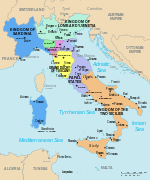
The Royal Order of Kamehameha I is an order of knighthood established by Kamehameha IV in 1852, to promote and defend the sovereignty of the Hawaiian Kingdom. Established by the 1852 Constitution, the Order of Kamehameha I is the second order of its kind in Hawaii.

The Order of the White Eagle is the highest order of merit of the Republic of Poland and one of the oldest distinctions in the world still in use. It was officially instituted on 1 November 1705 by Augustus II the Strong, King of Poland and Elector of Saxony, and bestowed on eight of his closest diplomatic and political supporters. It has since been awarded to the most distinguished Poles for their merits and to the highest-ranking representatives of foreign countries.

The Royal Order of the Sword is a Swedish order of chivalry and military decoration created by King Frederick I of Sweden on 23 February 1748, together with the Order of the Seraphim and the Order of the Polar Star. The motto of the order is in Latin: Pro Patria.

The Royal Norwegian Order of Saint Olav is a Norwegian order of chivalry instituted by King Oscar I on 21 August 1847. It is named after King Olav II, known to posterity as St. Olav.

The Royal Military Order of Saint George for the Defense of the Faith and the Immaculate Conception, also known as the Royal Bavarian House Equestrian Order of Saint George, was founded by Maximilian II Emanuel, Elector of Bavaria in 1729 to provide for a means of honouring the nobility and recognizing distinguished civil and military service.

The Royal Order of the Polar Star, sometimes translated as the Royal Order of the North Star, is a Swedish order of chivalry created by King Frederick I on 23 February 1748, together with the Order of the Sword and the Order of the Seraphim. The Order of the Polar Star is intended as a reward for Swedish and foreign "civic merits, for devotion to duty, for science, literary, learned and useful works and for new and beneficial institutions".

The Royal Order of Francis I was an extinct order of merit of the former Kingdom of the Two Sicilies which was annexed in 1861 by the King of Italy. It has been revived by Prince Carlo, Duke of Castro, as an award for services to charity and inter-religious understanding and includes a number of non-Roman Catholic statesmen and stateswomen among its membership.

The Imperial Order of Saint Stanislaus, also spelled Stanislas or Stanislav, is a Russian dynastic order of knighthood founded as Order of the Knights of Saint Stanislaus, Bishop and Martyr in 1765 by King Stanisław II Augustus of the Polish–Lithuanian Commonwealth. In 1831 after the downfall of the November Uprising, the order was incorporated into the Chapter of Russian Orders as part of the honours system of the Russian Empire by Emperor Nicholas I of Russia.
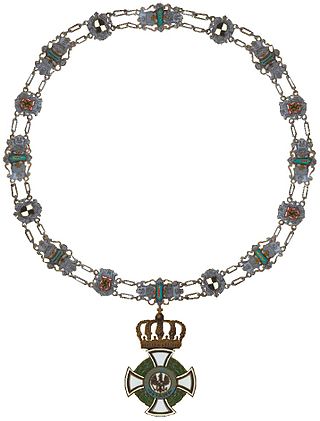
The House Order of Hohenzollern was a dynastic order of knighthood of the House of Hohenzollern awarded to military commissioned officers and civilians of comparable status. Associated with the various versions of the order were crosses and medals which could be awarded to lower-ranking soldiers and civilians.

Prince Ferdinand Pius, Duke of Calabria and Castro, was head of the House of Bourbon-Two Sicilies and pretender to the throne of the extinct Kingdom of the Two Sicilies from 1934 to 1960.

The Order of Saint George of the Reunion is an order of knighthood of the Kingdom of the Two Sicilies. It was established to replace the Royal Order of the Two-Sicilies.
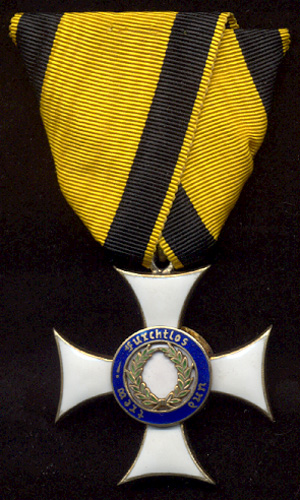
The Military Merit Order (Militärverdienstorden) was a military order of the Kingdom of Württemberg, which joined the German Empire in 1871. The order was one of the older military orders of the states of the German Empire. It was founded on 11 February 1759 by Karl Eugen, Duke of Württemberg as the Militär-Carls-Orden, and was renamed the Militärverdienstorden on 11 November 1806 by King Friedrich I. The order underwent several more revisions over the course of the 19th and early 20th centuries. It became obsolete with the fall of the Württemberg monarchy in the wake of Germany's defeat in World War I.
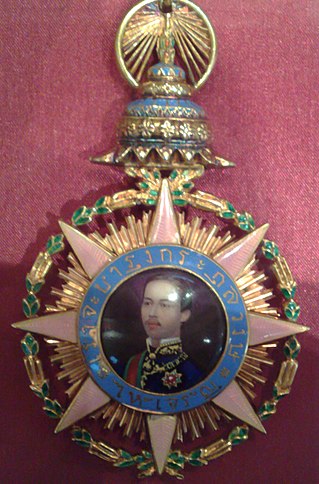
The Most Illustrious Order of Chula Chom Klao was established on 16 November 1873 by King Rama V of The Kingdom of Siam to commemorate the 90th Jubilee of the Chakri Dynasty and bears his name. The pink colour reflects the Tuesday birthday colour for King Rama V.
The Order of Military Merit is a Bulgarian order during the Kingdom of Bulgaria and the Republic of Bulgaria. It is the third highest order in the Republic of Bulgaria along with the Order of Civil Merit and the Order of the Madara Rider.
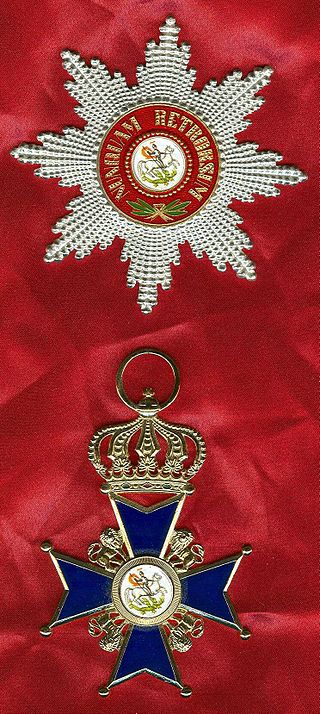
The Order of St. George, was founded by Ernest Augustus, King of Hanover, on 23 April 1839. In the statutes establishing the order it was designated as the House Order of the Crown of Hanover. The order is of a single grade and limited to 16 members, excluding members of the royal family.

The Military Order of Savoy was a military honorary order of the Kingdom of Sardinia first, and of the Kingdom of Italy later. Following the abolition of the Italian monarchy, the order became the Military Order of Italy.
The Order of Saints Cyril and Methodius is an award conferred by the Republic of Bulgaria.

The Hungarian Order of Merit is the fourth highest State Order of Hungary. Founded in 1991, the order is a revival of an original order founded in 1946 and abolished in 1949. Its origins, however, can be traced to the Order of Merit of the Kingdom of Hungary which existed from 1922 until 1946.

The Most Illustrious Order of Queen Sālote Tupou III is a knighthood order of the Kingdom of Tonga.

The House Order of Henry the Lion In German: Hausorden Heinrichs des Löwen, was the House Order of the Duchy of Brunswick. It was instituted by William VIII, Duke of Brunswick on 25 April 1834. The ribbon of the Order was red with yellow edges. It had five grades: Grand Cross, Grand Commander with Sash, Commander, Knight 1st Class, Knight 2nd Class, plus Medal of Merit for Science and Arts, the Cross of Merit and the Medal of Honour. The Order was named in honour of Henry the Lion, who remains a popular figure to this day.





